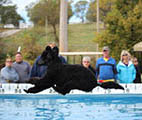TREATMENT OF SEIZURES
PHENOBARBITAL (PB) VERSUS POTASSIUM BROMIDE (KBr)
There are two anticonvulsant (anti-seizure) medications that are most typically prescribed for dogs, both of which are effective at controlling seizures. One is Phenobarbital (PB) and the other is Potassium Bromide (KBr). Both are excellent and reasonably safe, but each has its advantages and disadvantages. Sodium Bromide (NaBr) is also occasionally used and is very similar to KBr, although the recommended dosage is different. When deciding which of the anticonvulsant medications to try first, it is usually best to use the one that your veterinarian feels most comfortable with.
All medications (as well as “natural” treatments) can have side effects. However, the advantages of controlling your dog’s seizures with anticonvulsants generally outweigh the negative side effects. Of course, each dog reacts differently. We’ll give you an outline of the pros and cons of each medication, but be sure to discuss this with your veterinarian.
Phenobarbital (PB) should take effect more quickly because it usually takes only 2 weeks for a particular dose to reach a stable level in the dog’s blood. Of course, you may find that the starting dose isn’t high enough, but this should be apparent more quickly with PB than with Potassium Bromide (KBr). PB also is slightly easier to administer since it is readily available in pill form and it is available from regular pharmacies.
The main disadvantage of PB is that when used long-term, some dogs will show liver problems. Thus, it is important to monitor the dog’s liver functioning on a regular basis. Most veterinarians recommend liver monitoring every 6 months. If you monitor your dog’s blood regularly, you should be able to catch liver problems before they become serious, and then you can decrease the dose and/or switch to potassium bromide, which does not hurt the dog’s liver. We should note that in a small number of cases, the liver problems from PB are not caught in time, and the damage is not reversible. These cases are not common, but they do occur. The other disadvantage is that dogs generally need to be dosed at regular 12-hour intervals (for example, 7 AM and 7 PM). Depending on the predictability of your work schedule, this may or may not be a problem. Some dogs do fine if the owner is an hour or so early or late, but some dogs need the regularity of a dose every 12 hours in order to get good seizure control. In some very rare cases, a dog may show some blood abnormalities as a reaction to PB. However, these are very rare “idiosyncratic” reactions and are not related to the dose of PB. Also, these effects are reversible if you stop the PB.
The main advantage of potassium bromide (KBr) over PB as the first drug of choice is that, as mentioned, KBr does not hurt the liver. KBr was the very first anticonvulsant used with human epilepsy in the mid and late 1800s, but it rarely used for human epilepsy now because there are many more highly effective drugs for people. Unfortunately, many of these human drugs do not work well with dogs because the dog’s liver metabolizes them so quickly that you would have to dose your dog every few hours. And many are extremely expensive. Nonetheless, if neither PB nor KBr works well enough, there are some newer drugs that are effective for some dogs, such as Keppra and Zonegran.
Another advantage of KBr is that you don’t need to stick to such a strict dosing schedule. In fact, from a seizure-control viewpoint, you could easily give KBr just once each day. However, you may want to dose twice daily to break up the medication because a high dose at one time can upset the stomach, and it tastes bad. To combat the bad taste, the KBr liquid can be dropped onto a piece of bread or some special doggie treat that can absorb the liquid. You can mix the KBr liquid into a small bowl of instant oatmeal (cooled off), or you can mix it with a few bites of canned food, yogurt, applesauce, etc. It is NOT recommended that you mix it with the dog’s regular meal because if the dog does not finish the meal, you have no way to know how much KBr he/she got.
A disadvantage of KBr is that it takes longer to show its true effect. That is, it takes longer to stabilize its level in the blood. Thus, you may not know the true effect of a particular dose for 3 or 4 months. Importantly, this does not mean that your dog won’t show any improvement for 3 or 4 months. Many will show some improvement within a couple weeks. However, finding the right dose and schedule is likely to take longer than with PB. Thus, when dogs are having very frequent or very severe seizures, you want to get the seizures under control more quickly. In this situation, some veterinarians will begin with a very high dose of KBr (called a “loading dose”). A drawback of using such a large loading dose is that the side effects can be severe. Thus, if a loading dose is used, it is good to divide the loading dose (for example, divided over 5 days) so it is not given all at once.
A very small number of dogs react so badly to KBr that they become almost psychotic. They may run around all night screaming, for example. However, it is very rare when this occurs and it is completely reversible. That is, if you stop the drug immediately, you will see improvement pretty quickly and there are no lasting effects. Once the medication clears the dog’s system, the dog is just fine. Also, for the very small number of dogs who react that way, you will see this reaction shortly after you begin the drug. It is not something that could come out of the blue after you have been using the drug for a while.
Some veterinarians have reported that pancreatitis (inflammation of the pancreas) seems to be more common in dogs taking bromide. However, despite these reports, no one has proven that the higher rates of pancreatitis are actually caused by the bromide. In other words, it is not clear if it is the bromide that is causing the problem or something else that these particular dogs are doing. (For example, one might speculate that since bromide tastes bad, many owners give their dogs very tasty, high fat treats to get them to take the medication. So it could be these extra high fat treats rather than the bromide itself that cause the pancreatitis.) Also, there is no good explanation for why bromide might affect the pancreas this way. Still, the fact that pancreatitis may be more common in dogs taking bromide suggests that it would be a good idea to monitor your dog for this.
KBr is a little harder to obtain because it is not available in regular pharmacies. It must be compounded by a compounding pharmacy. Most towns have one of these, or you can get it mail order. Sometimes, mail order gives the best price. You just have to check and compare prices with what the compounding pharmacy in your area charges. If you go to this web site <http://www.canine-epilepsy.com> there is a section on mail order pharmacies. KBr comes in liquid form, although you can order capsules made up once you find the right dose. However, capsules are more expensive and you have no ability to make small changes in dose if you need to. Additionally, capsules can sometimes increase stomach problems because the KBr is dumped into the stomach all at once. So we recommend the liquid.
Another thing to keep in mind when using KBr is that you should try not to change their diet in any major way once you have found the right dose of KBr. This is because bromide competes with the chloride in their diet. (Note we said chloride–not sodium.) What this means is that if you noticeably increase the amount of chloride in their diet, this will cause more bromide to be eliminated in their urine, which can lead to seizures if the bromide level gets too low. In contrast, if you change their diet to one with noticeably less chloride, this will cause the bromide level in their blood to increase, which can lead to more serious side effects. It doesn’t appear to matter whether the dog is getting a lot of chloride or only a little bit of chloride in his diet. What’s important is whether you change their diet in a major way. Giving a new kind of treat now and then shouldn’t hurt anything, but changing dog foods can make a difference if the old and new diets differ in their chloride content. (All food companies should be able to provide chloride content information if you call their customer service department.) If you do need to change the dogs diet to one with a lot more (or less) chloride, be sure to discuss with your veterinarian how to make the proper adjustment in the dogs dose of KBr. Interestingly, a recent study raised the possibility that major changes in dietary protein and fat can influence the level of Phenobarbital in the blood. So whether you use KBr or PB, you should monitor what happens to the blood level of the drug in the event that you need to make significant changes in the dog’s diet.
Importantly, with both drugs, you should monitor the dog’s blood level regularly to be sure that the amount of the drug that remains in his or her blood is within the “therapeutic range.” This is the range within which the majority of dogs will show a beneficial effect on their seizures without showing unacceptable side effects. Some dogs do best at the very low end of this range, but others need to be at the very high end. Thus, the decision to raise, lower, or keep the dose the same needs to be based on a consideration of the blood level of the drug and how the dog is doing clinically in terms of having the seizures under control and not showing unacceptable side effects.
The primary side effects of both drugs are sedation and weakness in their legs (which often is most noticeable in the rear legs). However, this often goes away once the dog’s system gets used to the drug. It can take a few weeks from the time he starts the drug or has an increase in dose. If these effects do not subside in a few weeks (or if these side effects are so strong that they are intolerable), you should talk with your veterinarian about lowering the dose a small amount. A few dogs react in the opposite way and become more excitable and restless when they begin taking these medications. Like the sedation, this often resolves in a few weeks, but in some dogs will require a change in dose.
Other common effects of both medications include increases in appetite, urination, and drinking. You will need to watch your dog to be sure that he or she doesn’t eat more than needed. Dogs can act as if they are starving and gain an unhealthy amount of weight. Also, because they tend to urinate more and drink more, they may need to go outside more frequently to avoid accidents. Of course, as we have said before, each dog reacts differently, and you just have to wait and see how yours reacts.
In summary, when deciding whether to use PB or KBr, both drugs are excellent choices. We have emphasized all the difficulties that can accompany each medication because we think that owners should be fully informed. However, we again want to emphasize that the advantages of controlling your dog’s seizures generally outweigh the disadvantages of medication (unless your dog is having only 1 or 2 mild seizures per year). Also, some dogs that become seizure-free on these drugs can later be weaned off medication, or at least have their dose greatly reduced. With human epilepsy, it is recommended that patients wait until they have been completely free of seizures for 2 straight years. We also would encourage dog owners to wait at least two years before they and their veterinarian try to wean their dog off anticonvulsants, or substantially reduce the dose. Importantly, if weaning is attempted, we encourage you to work closely with your veterinarian and try to reduce the dose VERY SLOWLY. Some dogs cannot be weaned off medication, or even have a significant reduction in dose, without having more frequent seizures. This is particularly true for dogs that initially had some difficulty getting good seizure control. However, many of our research participants have reported that after weaning their dog off medication, he or she remained completely seizure free. For the most part, these “successful” dogs are the ones whose seizures came under control fairly quickly with medication.
When using any anticonvulsants, it is a good idea to keep a record of whenever your dog has a seizure (or suspected seizure). That way, if the dog starts to show a small improvement from medication, you will be able to tell more easily. Use whatever system is best for you, but many find it helpful to use a calendar with space by each day for writing notes. Keep the calendar readily available so you can easily write down whenever a seizure occurs. You want to write the time of day and any other descriptive information that occurs to you. For example, it is helpful to note if the episode was particularly severe or mild, how long it lasted, how long it took the dog to recover completely, and what kind of movements or behaviors the dog showed. After some time has passed, you can, if you wish, make a graph of how many seizures your dog had each week or each month so you can more clearly see if the seizures are decreasing.
It sometimes takes a long time to see improvement with anticonvulsants. For some dogs, it can take many months to get the seizures under good control. Sometimes, your veterinarian may need to raise the dose several times and/or add or substitute a second anticonvulsant before you see improvement. So lots of patience, a willingness to try different things, and careful monitoring of the dog’s blood (to see if the level of medication that remains in the blood is within the “therapeutic range”) may be necessary for success. However, some dogs respond to anticonvulsants very quickly. That is, they show a dramatic decrease in seizures, or even a complete cessation of all seizures, within a couple weeks of starting medication. It is impossible to know ahead of time how an individual dog will respond. But patience often pays off!
©Barbara G. Licht, PhD, 2010
Used with Permission,
Last updated 3/01/2010
The information contained in these documents is current at the time of this writing and is accurate to the best of VIP’s knowledge.
This information has been provided to you at no charge. You are free to use it provided it is used in its entirety with no changes or alterations and that the copyright remains intact. If you have found this information to be helpful, please consider making a tax-deductible donation to:
Versatility in Poodles
4061 Highlands Rd
Franklin, NC 28734
To make a donation via PayPal, please click the Donate Button:
The contents of the www.vipoodle.org website, such as text, graphics, images, and other material contained on this site (“Content”) are for informational purposes only. The Content is not intended to be a substitute for professional veterinarian advice, diagnosis, or treatment. Always seek the advice of your veterinarian with any questions you may have regarding the medical condition of your pet. Never disregard professional advice or delay in seeking it because of something you have read on this website!
If you think your pet has a medical emergency, call or visit your veterinarian or your local veterinary emergency hospital immediately. Versatility in Poodles and www.vipoodle.org do not recommend or endorse any specific veterinarians, products, procedures, opinions, or other information that may be mentioned on this website. Reliance on any information appearing on this website is entirely at your own risk.















